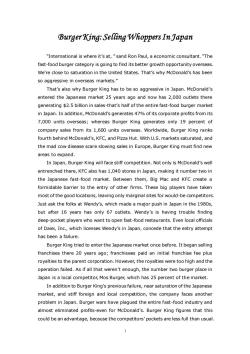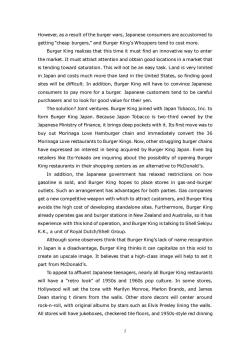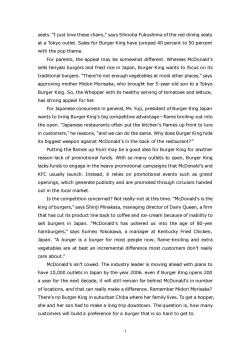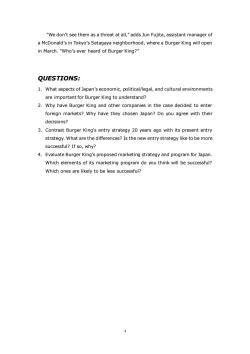《市场营销学》课程教学案例(双语)Selling Whoppers In Japan

Burger King:Selling Whoppers In Japan "International is where it's at,"sand Ron Paul,a economic consultant."The fast-food burger category is going to find its better growth opportunity overseas We're close to saturation in the United States.That's why McDonald's has been so aggressive in overseas markets." That's also why Burger King has to be so aggressive in Japan.McDonald's entered the Japanese market 25 years ago and now has 2,000 outlets there generating $2.5 billion in sales-that's half of the entire fast-food burger market in Japan.In addition,McDonald's generates 47%of its corporate profits from its 7,000 units overseas;whereas Burger King generates only 19 percent of company sales from its 1,600 units overseas.Worldwide,Burger King ranks fourth behind McDonald's,KFC,and Pizza Hut.With U.S.markets saturated,and the mad cow disease scare slowing sales in Europe,Burger King must find new areas to expand. In Japan,Burger King will face stiff competition.Not only is McDonald's well entrenched there,KFC also has 1,040 stores in Japan,making it number two in the Japanese fast-food market.Between them,Big Mac and KFC create a formidable barrier to the entry of other firms.These big players have taken most of the good locations,leaving only marginal sites for would-be competitors. Just ask the folks at Wendy's,which made a major push in Japan in the 1980s, but after 16 years has only 67 outlets.Wendy's is having trouble finding deep-pocket players who want to open fast-food restaurants.Even local officials of Daiei,Inc.,which licenses Wendy's in Japan,concede that the entry attempt has been a failure. Burger King tried to enter the Japanese market once before.It began selling franchises there 20 years ago;franchisees paid an initial franchise fee plus royalties to the parent corporation.However,the royalties were too high and the operation failed.As if all that weren't enough,the number two burger place in Japan is a local competitor,Mos Burger,which has 25 percent of the market. In addition to Burger King's previous failure,near saturation of the Japanese market,and stiff foreign and local competition,the company faces another problem in Japan.Burger wars have plagued the entire fast-food industry and almost eliminated profits-even for McDonald's.Burger King figures that this could be an advantage,because the competitors'pockets are less full than usual
1 Burger King: Selling Whoppers In Japan “International is where it’s at, ” sand Ron Paul, a economic consultant. “The fast-food burger category is going to find its better growth opportunity overseas. We’re close to saturation in the United States. That’s why McDonald’s has been so aggressive in overseas markets.” That’s also why Burger King has to be so aggressive in Japan. McDonald’s entered the Japanese market 25 years ago and now has 2,000 outlets there generating $2.5 billion in sales-that’s half of the entire fast-food burger market in Japan. In addition, McDonald’s generates 47% of its corporate profits from its 7,000 units overseas; whereas Burger King generates only 19 percent of company sales from its 1,600 units overseas. Worldwide, Burger King ranks fourth behind McDonald’s, KFC, and Pizza Hut. With U.S. markets saturated, and the mad cow disease scare slowing sales in Europe, Burger King must find new areas to expand. In Japan, Burger King will face stiff competition. Not only is McDonald’s well entrenched there, KFC also has 1,040 stores in Japan, making it number two in the Japanese fast-food market. Between them, Big Mac and KFC create a formidable barrier to the entry of other firms. These big players have taken most of the good locations, leaving only marginal sites for would-be competitors. Just ask the folks at Wendy’s, which made a major push in Japan in the 1980s, but after 16 years has only 67 outlets. Wendy’s is having trouble finding deep-pocket players who want to open fast-food restaurants. Even local officials of Daiei, Inc., which licenses Wendy’s in Japan, concede that the entry attempt has been a failure. Burger King tried to enter the Japanese market once before. It began selling franchises there 20 years ago; franchisees paid an initial franchise fee plus royalties to the parent corporation. However, the royalties were too high and the operation failed. As if all that weren’t enough, the number two burger place in Japan is a local competitor, Mos Burger, which has 25 percent of the market. In addition to Burger King’s previous failure, near saturation of the Japanese market, and stiff foreign and local competition, the company faces another problem in Japan. Burger wars have plagued the entire fast-food industry and almost eliminated profits-even for McDonald’s. Burger King figures that this could be an advantage, because the competitors’ pockets are less full than usual

However,as a result of the burger wars,Japanese consumers are accustomed to getting"cheap burgers,"and Burger King's Whoppers tend to cost more. Burger King realizes that this time it must find an innovative way to enter the market.It must attract attention and obtain good locations in a market that is tending toward saturation.This will not be an easy task.Land is very limited in Japan and costs much more than land in the United States,so finding good sites will be difficult.In addition,Burger King will have to convince Japanese consumers to pay more for a burger.Japanese customers tend to be careful purchasers and to look for good value for their yen. The solution?Joint ventures.Burger King joined with Japan Tobacco,Inc.to form Burger King Japan.Because Japan Tobacco is two-third owned by the Japanese Ministry of Finance,it brings deep pockets with it.Its first move was to buy out Morinaga Love Hamburger chain and immediately convert the 36 Morinaga Love restaurants to Burger Kings.Now,other struggling burger chains have expressed an interest in being acquired by Burger King Japan.Even big retailers like Ito-Yokado are inquiring about the possibility of opening Burger King restaurants in their shopping centers as an alternative to McDonald's. In addition,the Japanese government has relaxed restrictions on how gasoline is sold,and Burger King hopes to place stores in gas-and-burger outlets.Such an arrangement has advantages for both parties.Gas companies get a new competitive weapon with which to attract customers,and Burger King avoids the high cost of developing standalone sites.Furthermore,Burger King already operates gas and burger stations in New Zealand and Australia,so it has experience with this kind of operation,and Burger King is talking to Shell Sekiyu K.K.,a unit of Royal Dutch/Shell Group. Although some observers think that Burger King's lack of name recognition in Japan is a disadvantage,Burger King thinks it can capitalize on this void to create an upscale image.It believes that a high-class image will help to set it part from McDonald's. To appeal to affluent Japanese teenagers,nearly all Burger King restaurants will have a "retro look"of 1950s and 1960s pop culture.In some stores, Hollywood will set the tone with Marilyn Monroe,Marlon Brando,and James Dean staring t diners from the walls.Other store decors will center around rock-n-roll,with original albums by stars such as Elvis Presley lining the walls All stores will have jukeboxes,checkered tile floors,and 1950s-style red dinning
2 However, as a result of the burger wars, Japanese consumers are accustomed to getting “cheap burgers,” and Burger King’s Whoppers tend to cost more. Burger King realizes that this time it must find an innovative way to enter the market. It must attract attention and obtain good locations in a market that is tending toward saturation. This will not be an easy task. Land is very limited in Japan and costs much more than land in the United States, so finding good sites will be difficult. In addition, Burger King will have to convince Japanese consumers to pay more for a burger. Japanese customers tend to be careful purchasers and to look for good value for their yen. The solution? Joint ventures. Burger King joined with Japan Tobacco, Inc. to form Burger King Japan. Because Japan Tobacco is two-third owned by the Japanese Ministry of Finance, it brings deep pockets with it. Its first move was to buy out Morinaga Love Hamburger chain and immediately convert the 36 Morinaga Love restaurants to Burger Kings. Now, other struggling burger chains have expressed an interest in being acquired by Burger King Japan. Even big retailers like Ito-Yokado are inquiring about the possibility of opening Burger King restaurants in their shopping centers as an alternative to McDonald’s. In addition, the Japanese government has relaxed restrictions on how gasoline is sold, and Burger King hopes to place stores in gas-and-burger outlets. Such an arrangement has advantages for both parties. Gas companies get a new competitive weapon with which to attract customers, and Burger King avoids the high cost of developing standalone sites. Furthermore, Burger King already operates gas and burger stations in New Zealand and Australia, so it has experience with this kind of operation, and Burger King is talking to Shell Sekiyu K.K., a unit of Royal Dutch/Shell Group. Although some observers think that Burger King’s lack of name recognition in Japan is a disadvantage, Burger King thinks it can capitalize on this void to create an upscale image. It believes that a high-class image will help to set it part from McDonald’s. To appeal to affluent Japanese teenagers, nearly all Burger King restaurants will have a “retro look” of 1950s and 1960s pop culture. In some stores, Hollywood will set the tone with Marilyn Monroe, Marlon Brando, and James Dean staring t diners from the walls. Other store decors will center around rock-n-roll, with original albums by stars such as Elvis Presley lining the walls. All stores will have jukeboxes, checkered tile floors, and 1950s-style red dinning

seats."I just love these chairs,"says Shinoba Fukushima of the red dining seats at a Tokyo outlet.Sales for Burger King have jumped 40 percent to 50 percent with the pop theme. For parents,the appeal may be somewhat different.Whereas McDonald's sells teriyaki burgers and fried rice in Japan,Burger King wants to focus on its traditional burgers."There're not enough vegetables at most other places,"says approving mother Midori Morisaka,who brought her 5-year-old son to a Tokyo Burger King.So,the Whopper with its healthy serving of tomatoes and lettuce, has strong appeal for her. For Japanese consumers in general,Mr.Yuji,president of Burger King Japan wants to bring Burger King's big competitive advantage-flame broiling-out into the open."Japanese restaurants often put the kitchen's flames up front to lure in customers,"he reasons,"and we can do the same.Why does Burger King hide its biggest weapon against McDonald's in the back of the restaurant?" Putting the flames up front may be a good idea for Burger King for another reason-lack of promotional funds.With so many outlets to open,Burger King lacks funds to engage in the heavy promotional campaigns that McDonald's and KFC usually launch.Instead,it relies on promotional events such as grand openings,which generate publicity and are promoted through circulars handed out in the local market. Is the competition concerned?Not really-not at this time."McDonald's is the king of burgers,"says Shinji Minakata,managing director of Dairy Queen,a firm that has cut its product line back to coffee and ice-cream because of inability to sell burgers in Japan."McDonald's has ushered us into the age of 80-yen hamburgers,"says Sumeo Yokokawa,a manager at Kentucky Fried Chicken, Japan."A burger is a burger for most people now;flame-broiling and extra vegetables are at best an incremental difference most customers don't really care about." McDonald's isn't cowed.The industry leader is moving ahead with plans to have 10,000 outlets in Japan by the year 2006.even if Burger King opens 200 a year for the next decade,it will still remain far behind McDonald's in number of locations,and that can really make a difference.Remember Midori Morisaka? There's no Burger King in suburban Chiba where her family lives.To get a hopper, she and her son had to make a long trip downtown.The question is,how many customers will build a preference for a burger that is so hard to get to
3 seats. “I just love these chairs,” says Shinoba Fukushima of the red dining seats at a Tokyo outlet. Sales for Burger King have jumped 40 percent to 50 percent with the pop theme. For parents, the appeal may be somewhat different. Whereas McDonald’s sells teriyaki burgers and fried rice in Japan, Burger King wants to focus on its traditional burgers. “There’re not enough vegetables at most other places,” says approving mother Midori Morisaka, who brought her 5-year-old son to a Tokyo Burger King. So, the Whopper with its healthy serving of tomatoes and lettuce, has strong appeal for her. For Japanese consumers in general, Mr. Yuji, president of Burger King Japan wants to bring Burger King’s big competitive advantage—flame broiling-out into the open. “Japanese restaurants often put the kitchen’s flames up front to lure in customers,” he reasons, “and we can do the same. Why does Burger King hide its biggest weapon against McDonald’s in the back of the restaurant?” Putting the flames up front may be a good idea for Burger King for another reason-lack of promotional funds. With so many outlets to open, Burger King lacks funds to engage in the heavy promotional campaigns that McDonald’s and KFC usually launch. Instead, it relies on promotional events such as grand openings, which generate publicity and are promoted through circulars handed out in the local market. Is the competition concerned? Not really-not at this time. “McDonald’s is the king of burgers,” says Shinji Minakata, managing director of Dairy Queen, a firm that has cut its product line back to coffee and ice-cream because of inability to sell burgers in Japan. “McDonald’s has ushered us into the age of 80-yen hamburgers,” says Sumeo Yokokawa, a manager at Kentucky Fried Chicken, Japan. “A burger is a burger for most people now; flame-broiling and extra vegetables are at best an incremental difference most customers don’t really care about.” McDonald’s isn’t cowed. The industry leader is moving ahead with plans to have 10,000 outlets in Japan by the year 2006. even if Burger King opens 200 a year for the next decade, it will still remain far behind McDonald’s in number of locations, and that can really make a difference. Remember Midori Morisaka? There’s no Burger King in suburban Chiba where her family lives. To get a hopper, she and her son had to make a long trip downtown. The question is, how many customers will build a preference for a burger that is so hard to get to

"We don't see them as a threat at all,"adds Jun Fujita,assistant manager of a McDonald's in Tokyo's Setagaya neighborhood,where a Burger King will open in March."Who's ever heard of Burger King?" QUESTIONS: 1.What aspects of Japan's economic,political/legal,and cultural environments are important for Burger King to understand? 2.Why have Burger King and other companies in the case decided to enter foreign markets?Why have they chosen Japan?Do you agree with their decisions? 3.Contrast Burger King's entry strategy 20 years ago with its present entry strategy.What are the differences?Is the new entry strategy like to be more successful?If so,why? 4.Evaluate Burger King's proposed marketing strategy and program for Japan. Which elements of its marketing program do you think will be successful? Which ones are likely to be less successful?
4 “We don’t see them as a threat at all,” adds Jun Fujita, assistant manager of a McDonald’s in Tokyo’s Setagaya neighborhood, where a Burger King will open in March. “Who’s ever heard of Burger King?” QUESTIONS: 1. What aspects of Japan’s economic, political/legal, and cultural environments are important for Burger King to understand? 2. Why have Burger King and other companies in the case decided to enter foreign markets? Why have they chosen Japan? Do you agree with their decisions? 3. Contrast Burger King’s entry strategy 20 years ago with its present entry strategy. What are the differences? Is the new entry strategy like to be more successful? If so, why? 4. Evaluate Burger King’s proposed marketing strategy and program for Japan. Which elements of its marketing program do you think will be successful? Which ones are likely to be less successful?
按次数下载不扣除下载券;
注册用户24小时内重复下载只扣除一次;
顺序:VIP每日次数-->可用次数-->下载券;
- 《市场营销学》课程教学案例(双语)Egle Steel Supply Company.doc
- 《市场营销学》课程教学案例(双语)Who will go to Saudi Arabia.doc
- 《市场营销学》课程教学案例(双语)Summit Ski Produc.doc
- 《市场营销学》课程教学案例(双语)Van Der Steen Candy Company.doc
- 《市场营销学》课程教学案例(双语)The Pepsi and Coca-Cola Challenge-A Cola with Breakfast.doc
- 《市场营销学》课程教学案例(中文)第1章案例 营销与营销管理-亚马逊名震全球之道.doc
- 《市场营销学》课程教学案例(中文)第2章案例 规划企业战略与市场营销管理-雅戈尔,选择没有对错.doc
- 《市场营销学》课程教学案例(中文)第4章案例 分析消费者市场与购买行为-小阿华的“精确营销”.doc
- 《市场营销学》课程教学案例(中文)第3章案例 市场营销环境-恒伟药业信息调研出效益.doc
- 《市场营销学》课程教学案例(中文)第5章案例 市场细分、决定目标市场与定位- “红高粱”的启示.doc
- 《市场营销学》课程教学案例(中文)第7章案例 价格决策-海信空调的价格策略.doc
- 《市场营销学》课程教学案例(中文)第6章案例 产品决策-广东太阳神的产品组合.doc
- 《市场营销学》课程教学案例(中文)第9章案例 促销策略-中国肥皂泡戏煞东瀛人.doc
- 《市场营销学》课程教学案例(中文)第8章案例 分销渠道策略-通用公司打造全球供应链.doc
- 《市场营销学》课程授课教案(双语)Chapter 1 Marketing.doc
- 《市场营销学》课程授课教案(双语)Chapter 3 Analyzing the Marketing Environment.doc
- 《市场营销学》课程授课教案(双语)Chapter 5 Consumer Markets and Consumer Buyer Behavior.doc
- 《市场营销学》课程授课教案(双语)Chapter 4 Managing Marketing Information to Gain Customer Insights.doc
- 《市场营销学》课程授课教案(双语)Chapter 2 Company and Marketing Strategy.doc
- 《市场营销学》课程授课教案(双语)Chapter 11 Communicating Customer Value.doc
- 内蒙古科技大学:《市场营销学》课程作业习题(分章)市场营销学练习及答案(共九章).doc
- 内蒙古科技大学:《市场营销学》课程作业习题(综合)综合习题九.doc
- 内蒙古科技大学:《市场营销学》课程作业习题(综合)综合习题九答案.doc
- 内蒙古科技大学:《市场营销学》课程作业习题(综合)综合习题十.doc
- 内蒙古科技大学:《市场营销学》课程作业习题(综合)综合习题十答案.doc
- 内蒙古科技大学:《市场营销学》课程作业习题(综合)综合习题八答案.doc
- 内蒙古科技大学:《市场营销学》课程作业习题(综合)综合习题七答案.doc
- 内蒙古科技大学:《市场营销学》课程作业习题(综合)综合习题八.doc
- 内蒙古科技大学:《市场营销学》课程作业习题(综合)综合习题七.doc
- 内蒙古科技大学:《市场营销学》课程作业习题(综合)综合习题六.doc
- 内蒙古科技大学:《市场营销学》课程作业习题(综合)综合习题六答案.doc
- 内蒙古科技大学:《市场营销学》课程作业习题(综合)综合习题五.doc
- 内蒙古科技大学:《市场营销学》课程作业习题(综合)综合习题五答案.doc
- 内蒙古科技大学:《市场营销学》课程作业习题(综合)综合习题四答案.doc
- 内蒙古科技大学:《市场营销学》课程作业习题(综合)综合习题四.doc
- 内蒙古科技大学:《市场营销学》课程作业习题(综合)综合习题三答案.doc
- 内蒙古科技大学:《市场营销学》课程作业习题(综合)综合习题三.doc
- 内蒙古科技大学:《市场营销学》课程作业习题(综合)综合习题一答案.doc
- 内蒙古科技大学:《市场营销学》课程作业习题(综合)综合习题二答案.doc
- 内蒙古科技大学:《市场营销学》课程作业习题(综合)综合习题一.doc
